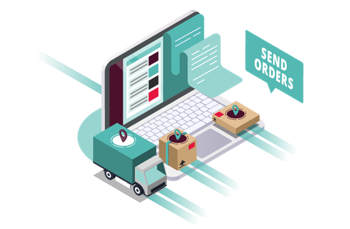5 downsides of an order management system
An order management system can deliver countless benefits for online retailers and third-party logistics providers (3PLs) – from automating manual tasks to delivering critical real-time insights.
But while many ecommerce businesses would struggle to fulfil growing customer demands without one, an order management system does come with its downsides. It is critical to be aware of these prior to making the decision to implement a new system.
At Access Mintsoft, we aim to provide you with all the facts – good or bad – about software solutions, so you can make an informed decision. If you are new to order management systems or are thinking about switching platforms, make sure to carefully weigh up the many benefits against the following five downsides.
Explore the 5 downsides of an order management system
1. Implementation can be expensive
The cost of a software implementation can vary. More sophisticated systems, with customised modules and features, will of course set you back more. Then you also have to consider the time it may take to implement the system, which could range from a few months to a year.
Aside from the initial set-up costs, the recurring cost of your software license or subscription must also be factored in. All these costs, however, should be considered against the time and financial savings you stand to gain by using a more efficient and powerful system.
Over time, these savings will add up to likely surpass the initial and recurring costs. Costs are off-set even more if you choose a cloud-based solution, as it does not require you to purchase and maintain costly server hardware.
2. The investment in training
Depending on how sophisticated or customised your order management system, getting to know the ins and outs of using it can take time and require training. While a software vendor may offer training as part of the implementation process, sometimes this is not sufficient for staff to fully grasp the system’s functionality and capabilities.
Additional training (including for new colleagues down the track) might come at a high cost. Plus, it is not always the case that a software vendor is able to deliver training right away, which means that your team may have to work out how to use the system themselves.
While many vendors provide phone and online technical support, in addition to online guides and resources, learning to use new software on your own takes far longer than via a few training sessions. If your staff do not know about the best ways to perform certain tasks, it could mean they are burdened with unnecessary work and could make mistakes that will add even more time to simple processes.
3. Missing integrations
When choosing an order management system, ensure that it offers in-built integrations with third-party ecommerce platforms like marketplaces, shopping carts, multi-carriers and couriers. It should also ideally come with an API connection so that you can create custom integrations with, for instance, your accounting software or ERP solution.
The danger of selecting software that does not offer such integrations is that you will be stuck managing multiple solutions separately, with no way to consolidate them into a central platform. This will place a significant burden on your time, and try your patience, by requiring you to constantly log into multiple systems and perform unnecessary manual processes to transfer data between them.
4. Poor customer support
The technical support provided by your software vendor is often the difference between a painful and smooth experience with your order management system. After purchasing a system, some businesses only realise how poor the vendor’s support is until they encounter a technical issue.
That is why while you are assessing systems, it is critical to do your due diligence and check what kind of support different vendors offer. Some may only offer online chat support and how-to guides, while others may be known for poor customer service.
It is a good idea to read online reviews of the support provided by different vendors, and maybe even ask some of your industry peers about their experiences. It is also wise to check whether their support team is located locally or overseas. The last thing you want is to be placed on hold for days waiting for an email reply to your support query.
5. Documents can’t be branded
Getting your business’s brand out there is essential. So you do not want to be locked in to an order management system that does not allow you to add customised branding to your documents.
While some systems provide the ability to add your logo and customise documents like invoices and dispatch notes, others do not. A solution that allows you to promote your brand and deliver more personalised customer interactions is always the better choice.
Selecting the best order management system for your business
Make sure to keep these downsides in mind as you research potential order management systems, to ensure you make your decision based on the full picture. But remember, not all systems come with these downsides, and they by no means overshadow the many benefits leading solutions offer.
Access Mintsoft, for instance, allows you to streamline order management via 175+ pre-built integrations with leading couriers, multi-carriers and marketplaces. It also features an open API connection so you can customise integrations with your core business solutions. Plus, you can easily personalise your customer documents with your business’s branding.
Given Access Mintsoft is a cloud-based solution, you do not need to worry about maintaining any servers and all security updates are automatically applied by us. We also offer a seamless implementation with our FlightPaths service, and you can rely on comprehensive technical support via phone and online with our Customer Success Plans.
CASE STUDY | How Black Bear Fulfillment benefited from Mintsoft OMS
Black Bear Fulfillment have a simple mission: To provide the high levels of fulfillment service to Australian customers, which they experienced as a former eCommerce seller in the US and UK. An eCommerce 3PL specialising in smaller consumer items, such as clothing and cosmetics, Black Bear Fulfillment are 100% Australian owned and operated. They are based in Melbourne and employ more than 40 people after launching just three years ago.
Unlike most 3PL’s they aren’t just focused on the logistics and warehousing side of the business, but also, importantly, the customer. Fulfillment is about people as much as it is logistics, and they needed a software solution to help bring this customer-centric vision to life.
Case Study
Read the Black Bear Fulfillment case study to learn more about how this Australian 3PL has leveraged the power of the Mintsoft solution to grow their business and deliver a world-class customer experience.
Want to know more?
Have a read through more order management resources, guidance and advice.



